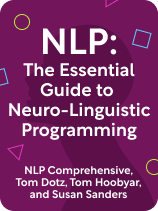

This article is an excerpt from the Shortform book guide to "NLP: The Essential Guide to Neuro-Linguistic Programming" by Tom Hoobyar, Tom Dotz, and Susan Sanders. Shortform has the world's best summaries and analyses of books you should be reading.
Like this article? Sign up for a free trial here.
What role do your senses play in shaping your thoughts and emotions? How do sensory experiences influence your behavioral choices and responses to different situations?
When you think about past experiences or imagine future scenarios, your brain processes information through various sensory channels. Understanding how these sensory modalities work can help you recognize their impact on your emotional responses and decision-making patterns.
Keep reading to discover how your brain constructs meaning from sensory experiences and learn why changing established thought patterns can be challenging.
Sensory Modalities & Their Nuances
Memory networks guide the trajectory of your thoughts, leading you to flit from one sensation to another. Now, let’s explain how nuances in sensory modalities contribute to this process, influencing not only what you think about your experiences but how you feel about and respond to those experiences.
All thoughts express themselves through your senses. Hoobyar, Dotz, and Sanders suggest that sensory nuances play a critical role in this process. The five sensory modalities (visual, auditory, olfactory, tactile, and gustatory) each have subtle variations in how they engage when you think about something:
- Visual modality: Variations in color, contrast, or size. When thinking about a past event, some details might appear vivid or large while others seem blurry or small.
- Auditory modality: Variations in volume or clarity. When recalling a conversation, you might hear loud, clear voices in your mind, or the voices might sound muffled and distant.
- Olfactory modality: Variations in intensity or complexity. When you think about freshly baked bread, you might smell a strong, rich aroma or just a faint whiff that barely registers.
- Tactile modality: Variations in pressure, temperature, or texture. When thinking about shaking someone’s hand, you might feel a light touch or the warmth of skin.
- Gustatory modality: Variations in flavor intensity or complexity. Thinking about what you plan to eat for dinner might evoke a strong, mouth-watering taste, or just a hint of flavor.
| How Sensory Impairments Influence Perception & Thought According to the authors, sensory nuances influence all your thoughts, feelings, and behaviors. But what happens when sensory impairments like blindness, deafness, anosmia (reduced sense of smell), hypoesthesia (numbness), or ageusia (reduced sense of taste) come into play? According to research, if you can’t use a sense when perceiving an experience, you won’t use its associated sensory nuances to think about that experience. Researchers explain that people with sensory impairments often depend on their remaining senses to perceive their environment—for example, someone with a visual impairment might rely heavily on the sounds and voices in a room to perceive the number of people present. This strategy then determines what sensory nuances they use when thinking about their experiences. For example, instead of visualizing faces in the crowded room, they might instead hear the rising cacophony of multiple people talking at once. |
Sensory Nuances Shape Your Emotional Responses & Behaviors
The authors explain that sensory nuances influence your emotional response to your thoughts, which then influences your subsequent thoughts, feelings, and behaviors. For example, if you vividly imagine the texture and taste of a snack you’re trying to avoid, you’ll likely experience a stronger craving than if you only vaguely recall its flavor—making you more likely to give in to temptation and eat the snack.
Since sensory nuances play a key role in how you think, feel, and respond to your experiences, they determine the types of experiences you move toward or away from. According to the authors, this is because they affect every phase of thinking about an experience:
- Before the experience, when you’re anticipating it: For example, thinking about an upcoming job interview, you visualize crystal-clear images of stern interviewers and hear their critical voices loudly in your mind. These nuances make you feel anxious, leading you to cancel the interview.
- During the experience, when you’re living it: For example, during a conversation, you focus intensely on the other person’s furrowed brow and slightly raised voice. These sensory nuances lead you to interpret their tone as confrontational, causing you to feel defensive and argumentative.
- After the experience, when you’re recollecting it: For example, thinking about a recent vacation, you see the vibrant colors of a sunset and hear the soothing sound of waves. These sensory nuances evoke feelings of relaxation and joy, encouraging you to plan similar trips in the future.
| Your Brain Constructs Your Emotional Responses to Sensory Nuances Lisa Feldman Barrett’s constructed emotion theory adds insight into how sensory nuances influence your emotions, determining what types of experiences you seek out. According to Barrett, your emotions are not fixed reactions to stimuli—meaning that you don’t always have the same emotional response to specific sensory nuances. This is because your brain actively constructs your emotions each moment. It does this by analyzing both your past experiences and the present context to determine a sensory nuance’s emotional significance. To illustrate, let’s continue with the job interview example, explaining the process that triggers anxiety: 1—You visualize stern interviewers. 2—Your brain sifts through your past experiences and analyzes your current circumstances to determine your emotional response to this sensory nuance. 3—Because you’ve had stressful interviews in the past and you currently need this job due to financial pressures, your brain decides that anxiety is a suitable emotional response. Next, Barrett explains that this emotional response determines your physiological state and behavioral impulses, influencing your decisions and responses. For example, if your brain decides that anxiety is a suitable emotional response, it might trigger a racing heart and induce a panic response, leading you to cancel the interview. This construction process explains why the same sensory nuance can evoke different emotional responses from you at different times. For example, imagining stern interviewers might cause intense anxiety if you’re currently unemployed, but only mild nervousness if you’re securely employed and exploring new options. |
Why It’s Difficult to Change Thoughts, Feelings, & Behaviors
Hoobyar, Dotz, and Sanders explain that, because this sensory-driven thought process typically occurs without your conscious involvement, you notice only the experience and your resulting emotion. This leads you to form unconscious associations between experiences and emotions, and these associations lead you to believe that you have no choice in how you think, feel, and respond to certain situations.
For example, when thinking about an upcoming interview, you don’t realize that the way you’re visualizing stern interviewers makes you feel anxious, which in turn makes you want to cancel your interview. Instead, you believe that job interviews are inherently stressful and intimidating, so you avoid them whenever possible.
| Feedback Loops Reinforce Unconscious Associations Maxwell Maltz (Psycho-Cybernetics) expands on how unconscious associations impact you, clarifying why it’s often difficult to change your thoughts, feelings, and behaviors. According to him, once your brain has created an association, it influences you to automatically think and behave in ways that reflect and reinforce that association. It does this by creating feedback loops: It triggers your emotions, which colors your perceptions and interpretations of your environment, which leads you to react in specific ways to stimuli. The feedback loop continually reinforces the association: The way your brain processes your environment justifies your habitual thoughts, feelings, and behaviors—and your habitual thoughts, feelings, and behaviors reinforce the way your brain processes your environment. For example, whenever you think about job interviews, your brain triggers a reaction that reinforces your anxiety—such as by inducing panic or urging you to avoid them. And, because you always feel anxious when you think about interviews, your brain automatically classifies them as anxiety-inducing situations. |

———End of Preview———
Like what you just read? Read the rest of the world's best book summary and analysis of Tom Hoobyar, Tom Dotz, and Susan Sanders's "NLP: The Essential Guide to Neuro-Linguistic Programming" at Shortform.
Here's what you'll find in our full NLP: The Essential Guide to Neuro-Linguistic Programming summary:
- How your thoughts form and impact you
- Why it’s difficult to control your thoughts
- The role senses play in your thoughts






